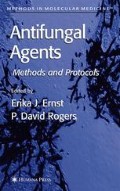Abstract
The growing importance of infectious caused by Aspergillus species during the last decade has created a need for practical and reproducible animal models of invasive aspergillosis suitable for studying fungal virulence, infection pathogenesis, diagnostic markers, and testing of antifungal therapy. Murine models remain the most commonly used models for studying aspergillosis because of their ease of manipulation and the large number of reagents available for studying disease-host responses. This chapter provides describes a murine model of invasive aspergillosis suitable for basic and translational studies of invasive pulmonary aspergillosis and highlights experimental variables that affect the course and reproducibility of infection.
Access this chapter
Tax calculation will be finalised at checkout
Purchases are for personal use only
References
Denning, D. W. (1996) Therapeutic outcome in invasive aspergillosis. Clin. Infect. Dis. 23, 608–615.
Lin, S. J., Schranz, J., and Teutsch, S. M. (2001) Aspergillosis case-fatality rate: systematic review of the literature. Clin. Infect. Dis. 32, 358–366.
Latge, J. P. (1999) Aspergillus fumigatus and aspergillosis. Clin. Microbiol. Rev. 12, 310–350.
Dixon, D. M., Polak, A., and Walsh, T. J. (1989) Fungus dose-dependent primary pulmonary aspergillosis in immunosuppressed mice. Infect. Immun. 57, 1452–1456.
Bowman, J. C., Abruzzo, G. K., Anderson, J. W., et al. (2001) Quantitative PCR assay to measure Aspergillus fumigatus burden in a murine model of disseminated aspergillosis: demonstration of efficacy of caspofungin acetate. Antimicrob. Agents Chemother. 45, 3474–3481.
Lehmann, P. F., and White, L. O. (1975) Chitin assay used to demonstrate renal localization and cortisone-enhanced growth of Aspergillus fumigatus mycelium in mice. Infect. Immun. 12, 987–992.
Latge, J. P. (2001) The pathobiology of Aspergillus fumigatus. Trends Microbiol. 9, 382–389.
Schaffner, A., Davis, C. E., Schaffner, T., et al. (1986) In vitro susceptibility of fungi to killing by neutrophil granulocytes discriminates between primary pathogenicity and opportunism. J. Clin. Invest. 78, 511–524.
Schaffner, A., Douglas, H., and Braude, A. (1982) Selective protection against conidia by mononuclear and against mycelia by polymorphonuclear phagocytes in resistance to Aspergillus. Observations on these two lines of defense in vivo and in vitro with human and mouse phagocytes. J. Clin. Invest. 69, 617–631.
Cenci, E., Mencacci, A., Fe d’Ostiani, C., et al. (1998) Cytokine-and T helperdependent lung mucosal immunity in mice with invasive pulmonary aspergillosis. J. Infect. Dis. 178, 1750–1760.
Cenci, E., Perito, S., Enssle, K. H., et al. (1997) Th1 and Th2 cytokines in mice with invasive aspergillosis. Infect. Immun. 65, 564–570.
Chandler, F. W., Kaplan, W., and L., A. (1980) Aspergillosis, in Color Atlas and Text of the Histopathology of Mycotic Diseases. Year Book Medical Publishers, Chicago, pp. 34–38.
Mielke, M. E., Autenrieth, I. B., and Held, T. K. (2002) The immune response in mice challenged with bacterial infections, in Immunology of Infection (Kaufman, S. H. E., and Kabelitz, D., eds.), Academic Press, London, pp. 359–401.
Acknowledgments
The authors thank Dr. Dimitrios P. Kontoyiannis for his contribution to our research in aspergillosis and the University of Texas MD Anderson Cancer Center, which is supported by NIH-NCI Cancer Center CORE Support Grant No. 16672.
Author information
Authors and Affiliations
Editor information
Editors and Affiliations
Rights and permissions
Copyright information
© 2005 Humana Press Inc.
About this protocol
Cite this protocol
Lewis, R.E., Wiederhold, N.P. (2005). Murine Model of Invasive Aspergillosis. In: Ernst, E.J., Rogers, P.D. (eds) Antifungal Agents. Methods in Molecular Medicine™, vol 118. Humana Press. https://doi.org/10.1385/1-59259-943-5:129
Download citation
DOI: https://doi.org/10.1385/1-59259-943-5:129
Publisher Name: Humana Press
Print ISBN: 978-1-58829-277-3
Online ISBN: 978-1-59259-943-1
eBook Packages: Springer Protocols

